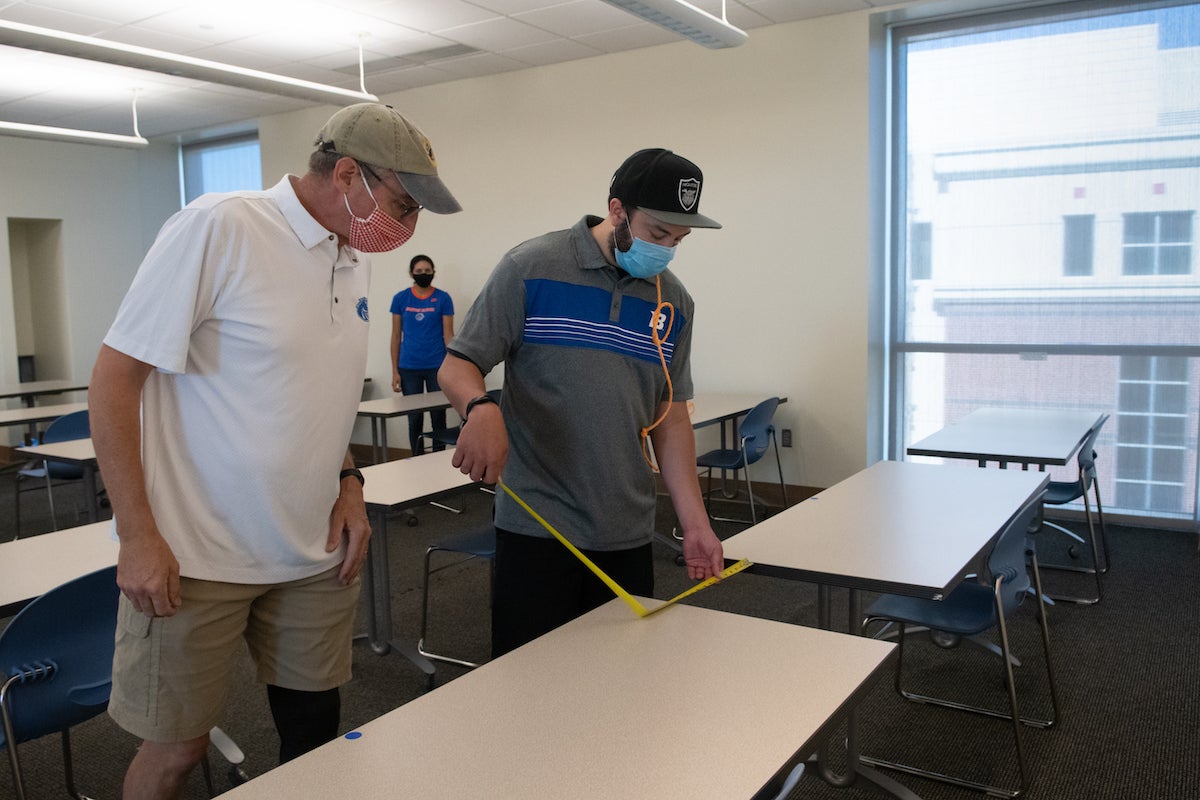
Imagine walking to your first class as an incoming freshman at Boise State and taking a seat in the stunning 2,037-seat theater at the Morrison Center, or in ExtraMile Arena. Learning in nontraditional spaces like these will be the new reality for some on-campus students this fall, as Boise State staff do their best to ensure students can learn safely in person while retaining a healthy distance from one another.
While roughly 50 percent classes are being taught online or remotely this fall (which translates to roughly 60 percent of seats), 50 percent of classes will be conducted in person, on campus.
Across campus, all classroom furniture will be arranged and marked with numbered decals indicating which seats can be used to ensure a six foot buffer between students. Diagrams of the proper layout will be placed in each classroom and the custodial staff will reset the rooms nightly as needed. Students will record which seat they sit in for each class to aid with contact tracing in the event of a positive COVID-19 case. Classroom spaces have also been analyzed to determine potential bottlenecks for ingress and egress, especially in larger spaces like ExtraMile Arena. These issues will be addressed with designated routes and signage for students to keep traffic flowing in a safe manner.
Getting classrooms ready for in person learning took the coordination of multiple groups across campus. Jim Munger, Boise State’s former vice provost for academic planning, led the effort from the provost’s office and was responsible for working with faculty to determine which classes were a priority to hold in person for the fall semester. A large team from the campus operations space management group determined capacity for different rooms around campus when factoring in adequate physical distancing for students and faculty. This information was then given to Kimber Shaw and the registrar’s office so class schedules and room locations could be updated based on the new availability.
“Health and safety is Boise State’s top priority, and I would like to commend the collaboration and creativity of our staff for the planning and precautions they’ve taken to ensure that students attending in-person classes this fall will be doing so in the safest possible environment, and one that supports their learning,” said Boise State Interim Provost and Vice President for Academic Affairs Tony Roark.
Under the guidance of campus operations staff, including Christy Jordan, Lee Keily, April Lanningham and Joey Martinez, all of the assigned classrooms and devise seating arrangements have been reconfigured to ensure a safe experience for campus users. The team used existing records of classroom capacity and furniture configurations as a starting point to determine what a reduced capacity in each classroom would look like. These calculations were verified in person as the team took measurements and designed layouts to ensure adequate physical distancing could be established for the determined number of students.
Some of the classes meeting in person this fall are foundational courses featuring a large number of students. This required the teams to get creative and look to spaces not traditionally used as classrooms. As a result, students may have a class in ExtraMile Arena, one of the Student Union ballrooms, or at the Morrison Center. These larger spaces provide the capacity needed for in demand classes and while also allowing for safe physical distancing.
Because of the space and furniture available, some of the classes meeting in the Student Union ballrooms will facilitate students to work in small groups safely. The ExtraMile Arena has been divided into two classrooms each holding up to 250 students. Arena staff and representatives from the Office of Information Technology (OIT) have combined the building’s existing broadcast technology with teaching resources to ensure the areas will function well as classrooms. ExtraMile arena and the Morrison Center each will use their existing ticketing systems to assign students seats in predetermined, physically distanced configurations.
Other non-traditional spaces to be used include the Hemingway Center gallery and the Liberal Arts gallery. Mark Fitzgerald and his OIT staff have worked diligently to ensure these spaces, and all rooms being used for classes, feature adequate technology to conduct classes. This team has purchased over 3,500 items – from cables to cameras to document readers – to ensure students and faculty have a positive experience in rooms that typically do not hold classes.
– By George Thoma